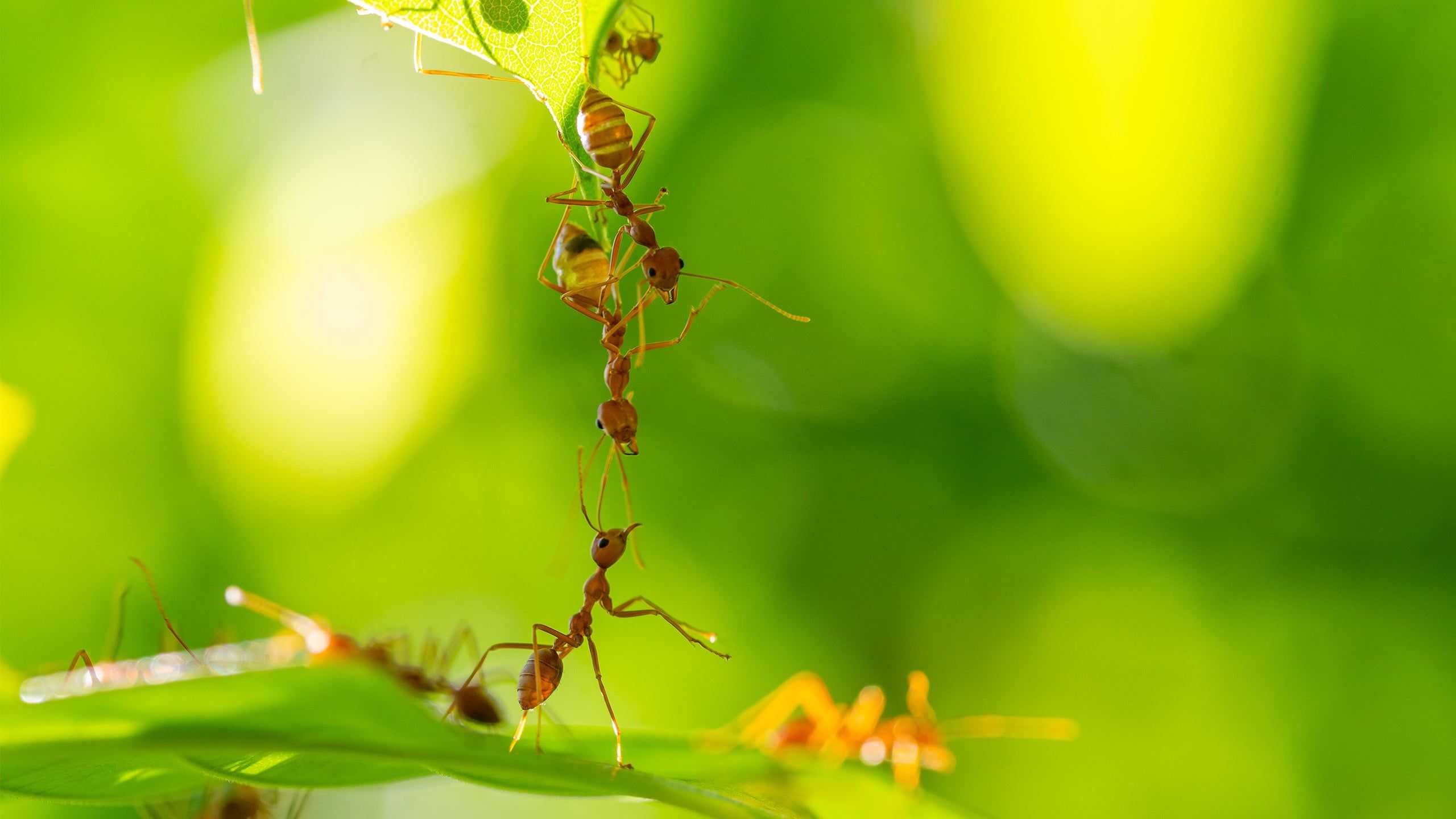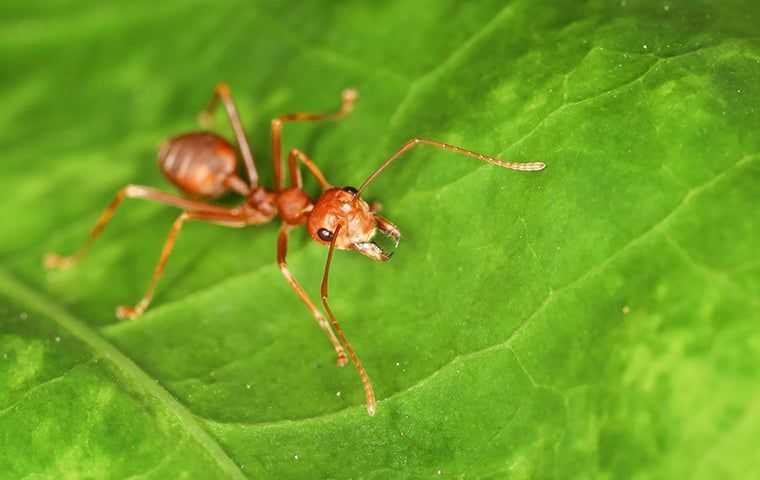
What You Need To Know About Ants In Bradenton, Florida

Over 700 ant species are found in the U.S., although only about 25 species commonly infest homes. Learn all about invasive species and other ants in the Bradenton area in this handy pest guide.
Frequently Asked Questions About Ants
What are ants?
Ants are social insects that typically live in underground colonies, made up of workers and a queen. Ants eat practically any food but are especially attracted to sweets.
Ant identification is relatively simple due to their three distinct body regions; head, thorax, and abdomen, and their antennae. Despite similar construction, ants vary in overall appearance. The best way to accurately identify the specific species of ants crawling around your property is to reach out to a local professional.
Below is a brief description of the ants most likely to invade our Bradenton, FL, properties.
Ghost Ant
Ghost ants are among the smallest ants found in Florida. Their head and thorax will be dark brown, and their legs will be pale in color, almost transparent. Their trails move slowly, but when disturbed, they scatter quickly and erratically. These ants are attracted to sweets. You'll generally find them in potted plants and under moist wooden structures.
Carpenter Ant
Carpenter ants are structural pests generally found inside wall voids and in attics. You will normally see carpenter ants active at dusk. They do not eat wood but excavate it to build their nests with wood particles.
Argentine Ant
Argentine ants produce the largest colonies, each of which can comprise thousands of ants. They are attracted to sweets. These ants are most common in shrubbery, where they protect and farm aphids, which produce honeydew, their main food source. Argentine ants will forage long distances, often traveling from one property to another.
Pyramid Ant
Pyramid ants are commonly outdoors. They nest in cracks in pavement, driveways, and walkways. They differ from fire ants in that their nests are volcano-shaped with one entry/exit instead of multiple entries/exits, as with fire ant mounds. Pyramid ants are beneficial insects preying on other pests such as fire ants, wasps, roaches, etc.
Red Imported Fire Ant
Fire ants are not commonly indoors; however, outside, they are pretty much anywhere, including shrub beds, the middle of the lawn, inside potted plants, and along sidewalks and driveways. A fire ant mound has multiple entries and exits.
If you've spotted ants crawling around your house, contact the experts at Westfall's Lawn and Pest right away.
Are ants dangerous?
There are ants living in Florida that are dangerous. Dangerous ants are those that pose threats to people or can damage the structures of our homes. In our region, the most dangerous ants to find their way to our properties are fire ants and carpenter ants.
Fire ants pose health risks to people. They have painful stings that can cause anaphylaxis, which can be life-threatening to older adults and infants.
Carpenter ants are ants whose nesting habits can cause structural damage. Carpenter ant damage does not happen overnight, but an untreated infestation will result in costly and extensive structural damage.
Though not all ants are dangerous, no species should be allowed to feel welcome in your home. Ants contaminate food, spread bacteria, produce foul odors, and are a nuisance to contend with daily.
What are fire ants?
Fire ants typically nest in the ground, and large colonies can have up to 250,000 workers. Very active and aggressive, they will sting any intruding animal repeatedly. Fire ants are omnivores, meaning they feed on animal or vegetable food sources.
Fire ant larvae are fed by the worker adults and eat only a liquid diet until their third larval instar is complete. Fourth instar larvae are capable of digesting solid foods. The total time it takes to develop from egg to adult averages 30 days. Workers may live up to 180 days. Queens live two to six years.
The red imported fire ant builds mounds in almost any type of soil but prefers open, sunny areas such as pastures, parks, lawns, meadows, and cultivated fields. You can also find colonies in or under buildings. Mounds containing colonies can reach 18 inches in height, depending on the type of soil.
Many times, mounds are located in rotting logs and around stumps and trees. Their mounds have no opening in the center like most ant mounds; red imported fire ants enter and exit the mound through underground tunnels. When their mounds are disturbed, the workers will come out of the ground and sting the intruder.
Fire ant activity ranges from the spring through the fall months. During the spring and summer months, the active mounds send out winged swarmer ants whose sole job is to start new colonies.
Sometimes the red imported fire ant will nest inside buildings during the winter months under bathtubs, when on a slab, or next to hot water heaters. The southern fire ant usually nests in loose soil, but sometimes you may find them in woodwork or masonry. Their nests are like crevices in the ground that spread out two to four feet. You'll find southern fire ant nests under houses, under boards or stones, or in cracks in the concrete.
Colonies frequently migrate from one site to another. The queen only needs a few workers to start a new colony. They can develop a new mound several hundred feet away from their previous location in a matter of hours. Flooding causes colonies to leave their mounds and float until they can reach land to establish a new mound.
If you notice fire ant mounds, please contact Westfall's Lawn and Pest.
Where will I find ants?
If you've ever found ants crawling across the kitchen counter or noticed a trail of little black ants on the bathroom floor, you're probably not alone. Ants are the number one nuisance pest in America.
A recent survey of pest professionals across the country conducted by the National Pest Management Association found kitchens (96%) and bathrooms (89%) particularly vulnerable to ants.
Kitchen: It's probably not surprising that the kitchen is considered a favorite ant hangout. In addition to food access, the sink provides a water source that ants need to survive. If you're lax about cleaning up crumbs and spills immediately, you may be inviting ants into your house.
Bathroom: Areas around the house with excess moisture are known to attract ants, so bathrooms are highly susceptible to infestations. Carpenter ants, for example, often build nests in damp areas, like behind bathroom tiles or under sinks.
The NPMA survey revealed that ants also invade the following areas:
- 73% - Inside walls
- 61% - Bedrooms
- 60% - Living rooms
- 54% - Basements
- 73% - Inside walls
Ants are small pests motivated to ensure their colony's success. If your home offers them what they want, ants will take advantage of any tiny crack or opening to get inside. When it comes down to it, any part of our Bradenton homes could become home to invading ants.
How do I get rid of ants?
Ants are some of the most challenging pests to control because colonies often contain thousands of members. If you notice ants inside your house, it's important to contact a licensed pest professional. Here at Westfall's Lawn and Pest, our professionals will perform a thorough inspection and complete effective home pest control treatments to rid ants from your property and prevent their return. Schedule a FREE inspection by calling us today! We are a local, family-owned business based in Bradenton, FL, since 2001.
How can I prevent ants in the future?
Here are a few tips to keep ants out of your home's kitchens and bathrooms.
Kitchens:
- Store sweet staples like sugar, syrup, and honey in plastic containers that snap shut, and wipe them down to remove any sticky residue.
- Place a bay leaf inside canisters of dry goods like flour to keep ants out. The herb's pungent scent repels ants and other common pantry pests.
- Clean up grease spills from countertops and floors as soon as they happen.
- Rinse out any empty juice or soda containers before recycling them or throwing them away. Make sure to take the trash out regularly.
- Keep an eye out for water buildup in the sink or leaks around the faucet.
- If you have pets, pick up any leftover food and wash the bowls regularly.
Bathrooms:
- Occasionally, inspect sinks, toilets, and tubs for leaks or drips.
- Give the bathroom a thorough cleaning by scrubbing the floors with disinfectant cleaner and wiping down the inside of drawers with warm soapy water.
- Make sure shampoo, lotion, and soap bottles are secure and that no contents have spilled out of their containers.
To keep ants from easily entering your home, experts recommend the following:
- Seal cracks in your foundation with silicone caulk.
- Repair holes in window and door screens.
- Replace weatherstripping.
- Fix loose mortar around the basement foundation and windows.
Another way to keep ants out is by keeping tree branches trimmed back and away from the house so they can't use them to climb over onto your home.



